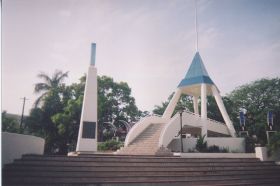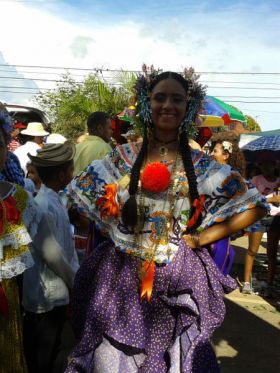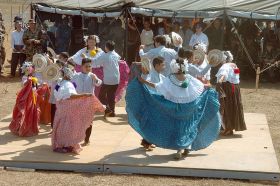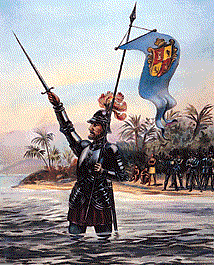What is the culture of Panama?
Louis Seldon
Cultures of Panama: Generally Spanish, but there is a monument in Amador that recognizes 9 cultures that contributed to the development of Panama.

.jpg)
Cultures of Panama: Generally Spanish, but there is a monument in Amador that recognizes 9 cultures that contributed to the development of Panama.

.jpg)
Posted April 12, 2013
Captain Carl Davis - Jungle Land Panama
Panama's culture is an eclectic mix of many other cultures. Because of Panama's unique geographical location, the country has always been a point of transit for travelers of the world. This is as true today as it was true during the colonial period.
Each region of Panama is quite different and they have all been influenced (to different extents) by other cultures. For example, the Azuero peninsula is known as one of the areas that was most influenced by the...
Panama's culture is an eclectic mix of many other cultures. Because of Panama's unique geographical location, the country has always been a point of transit for travelers of the world. This is as true today as it was true during the colonial period.
Each region of Panama is quite different and they have all been influenced (to different extents) by other cultures. For example, the Azuero peninsula is known as one of the areas that was most influenced by the Spanish, while Veraguas remained more indigenous. Colon is more Caribbean and Panama City is cosmopolitan. Even the local slang reflects the rich cultural variety, with many French, English, and Caribbean words being incorporated into the daily language here. And then of course, there is the former Panama Canal Zone, which developed its own "Zonian" subculture.
Panama is a "big" yet "small" country. It is small geographically but big in everything it has to offer culturally. The best way to experience the culture of Panama is to come and witness it for yourself!
Posted July 17, 2013
Lourdes Townshend
"Culture" is a great description for Panama, as Panama has been called the "races crucible" (crisol de razas) since the Pre-Colombinan (Pre-Colombina) Era, in the 15th century. Since then, Panama was the obliged path between "the Americas", and later in history, in the 20th century with the construction of the Panama canal, many people stayed in Panama for convenience and started a new era with different people from all over the world. ...
"Culture" is a great description for Panama, as Panama has been called the "races crucible" (crisol de razas) since the Pre-Colombinan (Pre-Colombina) Era, in the 15th century. Since then, Panama was the obliged path between "the Americas", and later in history, in the 20th century with the construction of the Panama canal, many people stayed in Panama for convenience and started a new era with different people from all over the world. As of today, still many people are seeking to come to Panama to establish their homes. Panama has always always welcomed people from around the world who want to enjoy our beautiful environment and warm people.
Posted August 8, 2013
Gilberto Barria Vallarino - BodyMind Dojo
The Panamanian Culture is influenced mostly by three general ethnic groups. First we have the indigenous cultures which vary from region to region, like the Kuna in San Blas and the Ngnobe in Chiriqui and Veraguas which are probably the largest groups. Then there is the Spanish culture whose influence started after 1492. The Spanish culture is a mix itself of the original indigenous people of Iberia like the Iberians, Basques, Celts and the Moors...
The Panamanian Culture is influenced mostly by three general ethnic groups. First we have the indigenous cultures which vary from region to region, like the Kuna in San Blas and the Ngnobe in Chiriqui and Veraguas which are probably the largest groups. Then there is the Spanish culture whose influence started after 1492. The Spanish culture is a mix itself of the original indigenous people of Iberia like the Iberians, Basques, Celts and the Moors which invaded Spain around the 800's (the Moors ruled Spain for 700 years). Then to that you have to add the Negro Culture which the Spanish brought to work as slaves. To that we have to add the influx of the Chinese which came at the time of the construction of the railroad during the Gold Rush in California. Finally during the construction of the Panama Canal at the beginning of the 20th Century Panama was influenced by the culture of many European nations and Negro cultures from the Antilles which were influenced by the British.
Posted October 25, 2013
Bill Hamilton - Bill Hamilton
 The culture in Panama is very old fashioned. They have lots of traditions. When a Panamanian girl reaches 15, she wears a beautiful special dress called a pollera (pictured). They dress her up, put makeup on and do her hair. It is really nice to see and very traditional.
The culture in Panama is very old fashioned. They have lots of traditions. When a Panamanian girl reaches 15, she wears a beautiful special dress called a pollera (pictured). They dress her up, put makeup on and do her hair. It is really nice to see and very traditional. The other thing I want to mention is if you meet someone and you’re talking to them, even if you know them reasonably well, they always call you “Senor.”...
 The culture in Panama is very old fashioned. They have lots of traditions. When a Panamanian girl reaches 15, she wears a beautiful special dress called a pollera (pictured). They dress her up, put makeup on and do her hair. It is really nice to see and very traditional.
The culture in Panama is very old fashioned. They have lots of traditions. When a Panamanian girl reaches 15, she wears a beautiful special dress called a pollera (pictured). They dress her up, put makeup on and do her hair. It is really nice to see and very traditional. The other thing I want to mention is if you meet someone and you’re talking to them, even if you know them reasonably well, they always call you “Senor.” They don’t say, “Hi, Bill.” They say, “Hola, Senor Bill.” I talk to the Panamanians this way, “Buenos dias, Senor Samuel.” “Buenos dias, Señora Marta.”
They also use "usted." They do not use "tu," which they do in Spain. Here, it is always usted. Usted is the formal version of “you” and tu is the familiar version. Even when you know people well and you are friends, you still use the formal. Panama is a fairly traditional conservative place.
If you ask a Panamanian to do something or if you can do something, they say, “como no”, which means “Of course.” They’re quite friendly and helpful. I said to a guy in my neighborhood one day, “Can I bring my friends up here to this place?” He said, “Como no, como no.” which is “Of course, of course.” They’re very formal, but at the same time very friendly and helpful.
Speaking personally, I’m a bit of conservative. I’ve never been out to dinner with shorts on. I wouldn’t even think of doing so. I’ve never worn shorts off the beach, but that is typical English. You just don’t wear shorts if you’re in a city or an urban area. I always use the formal way to talk to people, too.
Panamanians would do you a favor, but they usually ask for a favor in return at some time as well. That’s okay, it’s no problem. The other day, I went down with our neighbor, Martin. He showed me his property. He has geese and ducks. I love duck eggs, so he gave me a dozen duck eggs and a dozen hen eggs. Panamanians are so generous.
The Panamanian culture is very interesting because of the different tribes of Indians that exist here, and co-exist. There are multi nationalities and they all thrive together. There is no prejudice.
There are lots of Indian influences. You have the Ngobe Bugle, which is one Indian tribe. They have a different culture and they make different artifacts. You have the Kuna Yala, with the famous islands which are beautiful and are famous for the molas (traditional part of a costume and beautiful wall hangings) they make.
There are different cultures in Panama and they all blend in. You walk into the shopping mall and you see a Kuna Yala native wearing a traditional dress with bangles all up her legs and her arms. No one takes any notice, which is very interesting.
The indigenous Indians also mix their culture into their religion. My wife Mieke says that they mix their own tradition into the Roman Catholic faith.
Panama is much more relaxed than most places. It is much more easygoing than in the States and much more so than Europe. It is very laid back. Panamanians are so laid back about everything and they don’t even worry. If they don’t want to go to work one day, they won’t show up. They won’t tell you. They’ll say, “Oh I have enough to eat today and tomorrow, so I won’t go to work today.”
Promptness does not exist in Panama. If you have an appointment with someone at 9:00, he will show up at 10:30 and they won’t ring you or anything. You just wait and wait and wait and he will eventually turn up and he will say, “Oh sorry about that. There was a hold up in the traffic.”
Culture-wise, Panamanians like to eat. They go to restaurants a lot. They like to socialize. Families are very important and they are all very close-knit. They love and really adore kids. There are no child molestations in Panama, like there is in other places.
Posted December 12, 2014
Jennifer Moloney Jones
 Family is the most important part of the culture of Panama. Locals look after their grandmothers, their aunts, and their parents. People stay at home longer; usually until they are married. The Panamanian culture is rich in so many different ways. There are so many cultural influences here.
Family is the most important part of the culture of Panama. Locals look after their grandmothers, their aunts, and their parents. People stay at home longer; usually until they are married. The Panamanian culture is rich in so many different ways. There are so many cultural influences here. Panamanians love dancing and music. They are starting to love art, which is growing in interest exponentially here. When I first came to Panama, art...
 Family is the most important part of the culture of Panama. Locals look after their grandmothers, their aunts, and their parents. People stay at home longer; usually until they are married. The Panamanian culture is rich in so many different ways. There are so many cultural influences here.
Family is the most important part of the culture of Panama. Locals look after their grandmothers, their aunts, and their parents. People stay at home longer; usually until they are married. The Panamanian culture is rich in so many different ways. There are so many cultural influences here. Panamanians love dancing and music. They are starting to love art, which is growing in interest exponentially here. When I first came to Panama, art activities seemed to be very few, but now, there are art exhibitions all the time.
They are very proud of their country and they are proud to be Panamanians. In November, they celebrate Fiestas Patrias, which is the month when they celebrate their country and Panama’s independence. They deck their houses out in their national color and they put flags on their cars.
( Panamanian children performing danzas folklóricas (folk dances), pictured above.)
Posted March 12, 2015
Iván Eskildsen - Cubitá Group
 The culture of Panama is a very interesting topic.
The culture of Panama is a very interesting topic.Panama is known for being a melting pot of different cultures and ethnicities, where you can run into people from different areas and backgrounds. It is not unusual for a typical Panamanian to have in his family background Spanish, indigenous, Afro-Antillean (Caribbean), Chinese or other European backgrounds. This is the Panamanian identity.
The most firmly established identity in Panama is the colonial Spanish...
 The culture of Panama is a very interesting topic.
The culture of Panama is a very interesting topic.Panama is known for being a melting pot of different cultures and ethnicities, where you can run into people from different areas and backgrounds. It is not unusual for a typical Panamanian to have in his family background Spanish, indigenous, Afro-Antillean (Caribbean), Chinese or other European backgrounds. This is the Panamanian identity.
The most firmly established identity in Panama is the colonial Spanish identity. Chitré, which is towards the center of Panama, about 160 miles west of Panama City and at the northwestern edge of the Azuero Peninsula, and the Azuero Peninsula in general, is known as the cultural heart of Panama because it is here that the Spanish identity is centered.
We encourage people to get to know the Chitré area. Here, you can get to know the folklore and the folkloric dances, and where you can see the polleras (traditional Panamanian dress). There are festivities and parades throughout the year where people can come and get up close to get to know the very rich and interesting culture here. Before the Cubitá Boutique Resort & Spa, which we have developed, there did not exist an infrastructure that offered a high standard of service; we have really focused on providing this cultural experience, according to international levels of service, so finally local and foreign tourists can immerse themselves in the rich cultural traditions of the Azuero Peninsula.
(In 1513 Vasco Nuñez de Balboa was the first Spanish explorer to cross the isthmus of Panama, pictured.)
Posted August 16, 2015


